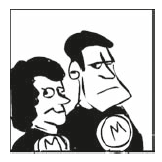How to use the Alter Ego strategy
In the previous chapters you found out how you can use your strengths to help you focus on the important task at hand. Different tasks require different states of mind. Extreme example: sorting out your tax receipts versus coming up with a name for a new product. The good news is that whether you know it or not, you already have these states within you. In this chapter you’ll find out how you can choose your state of mind and use this power to transform your use of time. The result will be that you will approach all tasks with maximum focus and effectiveness.
You have many personalities
Research has shown that the idea that a person has a stable, unchangeable personality that extends across all situations is an illusion. We act differently in different situations. The same person may be generous in some situations and stingy in others; gentle at times and aggressive at others, and so on.
Sometimes how we act depends on the people we’re with. Even as adults, for example, many people tend to revert to acting in a rather childlike way or to being on their best behaviour when they’re with their parents.
TWO VIEWS OF CONSISTENCY
“Consistency requires you to be as ignorant today as you were a year ago.”
Bernard Berenson (1865–1959), American art historian
“Consistency is the last refuge of the unimaginative.”
Oscar Wilde (1854–1900), Irish writer and wit
Sometimes how we act depends on the level of stress we are experiencing. Possibly you’ve been with a usually gentle and nice person who flew into a rage when they were pushed just that little bit too far. They may later say, “I’m sorry, I wasn’t myself”, but really they were themselves, just a different and perhaps usually rare version of themselves.
There’s nothing wrong with this inconsistency; in fact, it makes sense that we tailor our behaviour to different situations. But most people are not aware that they have a choice about how to respond, and that the range of choices they have represents a huge potential asset. Instead, people tend to ascribe their moods, attitudes, and even their behaviours to outside factors, with statements like these:
- “He makes me so mad.”
- “When she looks at me that way, I just can’t say no.”
- “When my to-do list gets too long, I can’t help going into a panic.”
You do have a choice
The Alter Ego strategy relates to deciding which of your many personalities would be most helpful in a given situation, and putting that one in charge. I call these personalities your Alter Egos. By putting the right one in charge, you will find that you get things done more effectively, efficiently and with less stress – even with enjoyment.
You can do this when you react to a situation as well as when you are planning to do a particular task. First, if you tend to respond to certain situations in a non-constructive way, you can stop that response and substitute another one. One example of this is the “counting to 10” rule when you’re getting angry. It gives you time to consider whether your mounting anger is really going to help the situation, and to respond differently. Even though the “hothead you” may want to be in charge, you can choose to put the “assertive but calm you” in control instead.
It works just as well when you are getting ready to handle a task. Let’s say you have to clean out the garage but you really don’t feel like it. You’d much prefer to lounge around and read the magazines that came in the post this morning. You could procrastinate and not clean the garage, or you could force yourself to do it, but still think about the fact that it would be nice to be lounging and reading. If you do the latter, cleaning the garage will probably take you a long time, be haphazard, and certainly be no fun.
Here’s how you could apply the Alter Ego technique to this situation.
- Pretend for a moment that you were going to hire someone to do the job for you. What kind of attributes and attitudes would you like this person to have? These might include being focused, not getting distracted, being rational (not sentimental) about what to throw away, being efficient, moving quickly and with purpose.
- Remember a time when you exhibited all or most of these qualities yourself. It need not have anything to do with the task at hand. It may be that you need to combine memories (for example, the time you were totally focused and the time you were rational about what needed to be done might be two different events).
- Stand up and use your memories to get into that state now. It helps to close your eyes and take a few minutes to get into this fully. Remember what you see when you feel this way, what you hear (for example, what you say to yourself or what others say to you), and how it feels inside to be this way. If you don’t have strong memories to draw upon, create the feelings using your imagination. It can be helpful to give this version of yourself a playful name.
- Now put this Alter Ego in charge and do whatever you need to do. If you find yourself snapping out of it, stop and quickly get back into the desired state. For instance, if you come across some old magazines in the garage and start to peruse them, stop, refocus, and get back to work.
A gallery of Alter Egos
Here are a few Alter Egos you might find useful.

Miss Moneypenny: Rational, efficient, conservative. Good person to put in charge when preparing your taxes, deciding about purchases, etc.
Attila: Strong, constantly aware of the goal, unyielding. Good person to put in charge when you’ve previously let others ride roughshod over your interests or needs, or when you’ve let yourself get too distracted from the task at hand.

Albert: Thinks out of the box, not afraid of failure or ridicule. Good person to put in charge when you need to be creative. A good choice for when you’re brainstorming.

Big Kid: Playful, adventurous, open-minded. Good person to put in charge when you find yourself taking things too seriously.

Mightyman/Mightywoman: Strong, self-assured, capable. Good person to put in charge when confidence is necessary, such as making presentations, making a phone call you’re not sure about, etc.

Sister Harmonia: Gentle, conciliatory, interested in finding the win-win situation for everybody concerned. Good person to put in charge when negotiating with reasonable people.
MORE ALTER EGOS
If you have trouble making up your own Alter Egos, watch a morning of cartoons and pick out the characters that work best for the moods you might want. If a moment calls for playful cheerfulness, SpongeBob Squarepants might just come in handy.
These are some of the Alter Egos I find useful; you may find it more helpful to come up with your own. Also, it may be necessary to change personalities in the middle of a situation – for example, if Sister Harmonia isn’t getting anywhere in a negotiation, at some point Attila may have to take over! But I hope you can see how things can go wrong when we unthinkingly let the wrong person take charge. You really don’t want Big Kid doing your tax returns, or Attila in charge of a first meeting with a possible client.
From now on you can choose which of your many personalities to put in charge. Here’s a quick summary of the process:
- Analyse the task at hand. What qualities are required in order to handle it?
- Use your memories and/or your imagination to create or recreate a personality who has those qualities, and get into the desired state. Give this Alter Ego a name.
- Put this Alter Ego in charge until the task is done, or until you reach a point at which a different one is called for.
- Complete the task, then consciously step out of that personality into either your more typical self, or into another Alter Ego that fits whatever you wish to do next.
Try out an Alter Ego
Now it’s time for you to plan how this technique will work for you. Below, write three types of tasks that you feel you could handle more effectively than you do now. Examples might include processing email, catching up with administrative backlog, making calls to potential clients or getting started on a new project.

Give a name to the Alter Ego (AE) that tends to handle each task for you now. For example, sometimes I find that I let the Big Kid check my email – which means that I follow all the interesting links, get distracted reading the news, etc. and an hour later I’m still not finished actually processing my email.

In the three blanks below, give a name to the Alter Ego who you think might do a better job of handling that task. In my case, probably Attila would be more appropriate, because he’s ruthless about zapping unimportant emails.

Finally, in the blanks below jot down how you think this preferred Alter Ego would handle the task. If it helps, close your eyes for a moment and get into character. In my example, Attila would immediately delete the junk mail, then he’d briskly put the other emails into folders to be handled at appropriate times. Before actually answering any messages, I might want to switch to a different Alter Ego, as Attila tends to be pretty brusque.

Hire yourself as the Consultant
An Alter Ego that can be useful in a variety of situations is the Consultant. You can get a fresh perspective on your life by pretending that you’re a high-priced consultant who has been called in to assess how to maximise the returns in your life. With a neutral, questioning attitude, analyse what you’re doing now and how you’re doing it, where the sticking points are, where more or new resources are needed, and so on.
This could apply to any phase of your life: the outcome could be making a certain amount of money, or having a great relationship with your children, or getting fit, for example. Usually you see your life in the “associated” view – that is, through your own eyes. When you look at it in a “dissociated” state – that is, as though watching it from the outside, as though on a movie screen, suddenly you get a whole different picture. To make this really vivid it helps to stand up, close your eyes, and recreate with all your senses what it would be like to be this other person. If you imagine the Consultant to be taller than you, for example, you might notice your posture shifting. If your image of the Consultant is someone who is less emotional than you, you may feel your mental state turning cooler.
Just like any consultant, note what’s working and what isn’t, what’s needed, what has worked for other people, and then write down your recommendations.
“Advice is what we ask for when we already know the answer but wish we didn’t.”
Erica Jong, American writer
Then get back into the associated state (in other words, your normal self) and read the report and decide which of the recommendations you want to accept, and begin to implement them. Periodically call in the Consultant to evaluate how things are going and what changes could help. You might even make the first day of each month your appointment with the Consultant.
Create your own arch-enemy
Usually it’s good to think positively, but sometimes a bit of strategic negative thinking can help, too. Have you noticed how hard people will work when they are fighting an enemy? The more specific the enemy, the better. You can use this power by creating a final variation of an Alter Ego: an arch-enemy who is the symbol of whatever may be holding you back.
Most of the time in reality this is not another person, but some aspect of yourself. For example, if you’re trying to lose weight and shape up, most likely it is your own problems with sticking to your diet and exercise regime that get in your way. You can create an image for this “enemy”. Maybe you want to imagine Blimpo – a cartoon-like hugely overweight and slobby creature. Blimpo hates it when you exercise or when you resist the lure of chocolates because Blimpo wants to make you into their own image.
Imagine your reaction if, the next time you are tempted, you call Blimpo to mind. Make the right choice and watch Blimpo deflate a little – enjoy the downfall of the enemy! The best thing is this all happens in your imagination. You do not need to tell anyone else about it – all they will notice is that you are doing better than ever before.
What’s next?
By using Alter Egos, you will have greater control of your own actions. Of course along the way you will have to deal with other people, and the next chapter will equip you to find and work with allies and to negotiate like a master.
Website chapter bonus
At www.focusquick.com you’ll find a downloadable visualisation that gets you into the Consultant Alter Ego and allows you mentally to rehearse how you might employ them.

